Hybrid Pressure Sensor Based on Carbon Nano-Onions and Hierarchical Microstructures with Synergistic Enhancement Mechanism for Multi-Parameter Sleep Monitoring
Abstract
:1. Introduction
2. Experimental Section
2.1. Fabrication of the CNOs@Ecoflex
2.2. Fabrication of the HPS
2.3. Characterization and Measurement
2.4. Statistical Analysis
3. Results and Discussion
3.1. Structure and Fabrication of the HPS
3.2. Working Principle and Performance Characterization of the HPS
3.3. Application of HPS in the Field of Sleep Monitoring
4. Conclusions
Supplementary Materials
Author Contributions
Funding
Data Availability Statement
Conflicts of Interest
References
- Peppard, P.E.; Young, T.; Barnet, J.H.; Palta, M.; Hagen, E.; Hla, K.M. Increased Prevalence of Sleep-Disordered Breathing in Adults. Am. J. Epidemiol. 2013, 177, 1006–1014. [Google Scholar] [CrossRef] [PubMed]
- Li, Y.Z.; Sahakian, B.J.; Kang, J.J.; Langley, C.; Zhang, W.; Xie, C.; Xiang, S.T.; Yu, J.T.; Cheng, W.; Feng, J.F. The brain structure and genetic mechanisms underlying the nonlinear association between sleep duration, cognition and mental health. Nat. Aging 2022, 2, 453. [Google Scholar] [CrossRef] [PubMed]
- Bonnet, M.H.; Arand, D.L. 24-Hour metabolic rate in insomniacs and matched normal sleepers. Sleep 1995, 18, 581–588. [Google Scholar] [CrossRef]
- Yo, S.W.; Joosten, S.A.; Wimaleswaran, H.; Mansfield, D.; Thomson, L.; Landry, S.A.; Edwards, B.A.; Hamilton, G.S. Body position during laboratory and home polysomnography compared to habitual sleeping position at home. J. Clin. Sleep Med. 2022, 18, 2103–2111. [Google Scholar] [CrossRef]
- Fernandez, E.; Kurlyandskaya, G.V.; Garcia-Arribas, A.; Svalov, A.V. Nanostructured giant magneto-impedance multilayers deposited onto flexible substrates for low pressure sensing. Nanoscale Res. Lett. 2012, 7, 230. [Google Scholar] [CrossRef]
- Benavides, L.S.; Silva, E.C.; Monteiro, E.C.; Barbosa, C.R.H. High sensitivity pressure transducer based on the phase characteristics of GMI magnetic sensors. Meas. Sci. Technol. 2018, 29, 035106. [Google Scholar] [CrossRef]
- Mohri, K.; Honkura, Y.; Panina, L.V.; Uchiyama, T. Super MI Sensor: Recent Advances of Amorphous Wire and CMOS-IC Magneto-Impedance Sensor. J. Nanosci. Nanotechnol. 2012, 12, 7491–7495. [Google Scholar] [CrossRef]
- Lin, Z.M.; Yang, J.; Li, X.S.; Wu, Y.F.; Wei, W.; Liu, J.; Chen, J.; Yang, J. Large-Scale and Washable Smart Textiles Based on Triboelectric Nanogenerator Arrays for Self-Powered Sleeping Monitoring. Adv. Funct. Mater. 2018, 28, 1704112. [Google Scholar] [CrossRef]
- Lee, S.; Park, J.W. Fingerprint-inspired triboelectric nanogenerator with a geometrically asymmetric electrode design for a self-powered dynamic pressure sensor. Nano Energy 2022, 101, 107546. [Google Scholar] [CrossRef]
- Zhang, P.C.; Zhang, Z.X.; Cai, J. A foot pressure sensor based on triboelectric nanogenerator for human motion monitoring. Microsyst. Technol. 2021, 27, 3507–3512. [Google Scholar] [CrossRef]
- Adepu, V.; Kamath, K.; Mattela, V.; Sahatiya, P. Development of Ti3C2Tx/NiSe2 Nanohybrid-Based Large-Area Pressure Sensors as a Smart Bed for Unobtrusive Sleep Monitoring. Adv. Mater. Interfaces 2021, 8, 2100706. [Google Scholar] [CrossRef]
- Peng, M.; Ding, Z.Z.; Wang, L.S.; Cheng, X.S. Detection of Sleep Biosignals Using an Intelligent Mattress Based on Piezoelectric Ceramic Sensors. Sensors 2019, 19, 3843. [Google Scholar] [CrossRef] [PubMed]
- Yu, J.; Xian, S.; Zhang, Z.; Hou, X.; He, J.; Mu, J.; Geng, W.; Qiao, X.; Zhang, L.; Chou, X. Synergistic piezoelectricity enhanced BaTiO3/polyacrylonitrile elastomer-based highly sensitive pressure sensor for intelligent sensing and posture recognition applications. Nano Res. 2023, 16, 5490–5502. [Google Scholar] [CrossRef]
- Dagdeviren, C.; Su, Y.W.; Joe, P.; Yona, R.; Liu, Y.H.; Kim, Y.S.; Huang, Y.A.; Damadoran, A.R.; Xia, J.; Martin, L.W.; et al. Conformable amplified lead zirconate titanate sensors with enhanced piezoelectric response for cutaneous pressure monitoring. Nat. Commun. 2014, 5, 4496. [Google Scholar] [CrossRef] [PubMed]
- Shi, J.D.; Wang, L.; Dai, Z.H.; Zhao, L.Y.; Du, M.D.; Li, H.B.; Fang, Y. Multiscale Hierarchical Design of a Flexible Piezoresistive Pressure Sensor with High Sensitivity and Wide Linearity Range. Small 2018, 14, 1800819. [Google Scholar] [CrossRef]
- Ding, X.C.; Zhong, W.B.; Jiang, H.Q.; Li, M.F.; Chen, Y.L.; Lu, Y.; Ma, J.; Yadav, A.; Yang, L.Y.; Wang, D. Highly Accurate Wearable Piezoresistive Sensors without Tension Disturbance Based on Weaved Conductive Yarn. ACS Appl. Mater. Interfaces 2020, 12, 35638–35646. [Google Scholar] [CrossRef]
- Liu, S.Y.; Lu, J.G.; Shieh, H.P.D. Influence of Permittivity on the Sensitivity of Porous Elastomer-Based Capacitive Pressure Sensors. IEEE Sens. J. 2018, 18, 1870–1876. [Google Scholar] [CrossRef]
- Mishra, R.B.; El-Atab, N.; Hussain, A.M.; Hussain, M.M. Recent Progress on Flexible Capacitive Pressure Sensors: From Design and Materials to Applications. Adv. Mater. Technol. 2021, 6, 2001023. [Google Scholar] [CrossRef]
- Hu, Q.S.; Tang, X.C.; Tang, W. A Real-Time Patient-Specific Sleeping Posture Recognition System Using Pressure Sensitive Conductive Sheet and Transfer Learning. IEEE Sens. J. 2021, 21, 6869–6879. [Google Scholar] [CrossRef]
- He, C.H.; Tan, J.W.; Jian, X.L.; Zhong, G.X.; Cheng, L.L.; Lin, J.Z. A Smart Flexible Vital Signs and Sleep Monitoring Belt Based on MEMS Triaxial Accelerometer and Pressure Sensor. IEEE Internet Things J. 2022, 9, 14126–14136. [Google Scholar] [CrossRef]
- Xu, X.W.; Lin, F.; Wang, A.S.; Hu, Y.; Huang, M.C.; Xu, W.Y. Body-Earth Mover’s Distance: A Matching-Based Approach for Sleep Posture Recognition. IEEE Trans. Biomed. Circuits Syst. 2016, 10, 1023–1035. [Google Scholar] [CrossRef] [PubMed]
- Shin, J.H.; Chee, Y.J.; Jeong, D.U.; Park, K.S. Nonconstrained Sleep Monitoring System and Algorithms Using Air-Mattress with Balancing Tube Method. IEEE Trans. Inf. Technol. Biomed. 2010, 14, 147–156. [Google Scholar] [CrossRef] [PubMed]
- Huang, M.C.; Liu, J.J.; Xu, W.Y.; Alshurafa, N.; Zhang, X.Y.; Sarrafzadeh, M. Using Pressure Map Sequences for Recognition of on Bed Rehabilitation Exercises. IEEE J. Biomed. Health Inform. 2014, 18, 411–418. [Google Scholar] [CrossRef] [PubMed]
- Lou, Z.; Chen, S.; Wang, L.L.; Jiang, K.; Shen, G.Z. An ultra-sensitive and rapid response speed graphene pressure sensors for electronic skin and health monitoring. Nano Energy 2016, 23, 7–14. [Google Scholar] [CrossRef]
- Yang, P.; Shi, Y.X.; Li, S.Y.; Tao, X.L.; Liu, Z.Q.; Wang, X.L.; Wang, Z.L.; Chen, X.Y. Monitoring the Degree of Comfort of Shoes In-Motion Using Triboelectric Pressure Sensors with an Ultrawide Detection Range. ACS Nano 2022, 16, 4654–4665. [Google Scholar] [CrossRef]
- Hu, C.F.; Wang, F.; Cui, X.H.; Zhu, Y.T. Recent progress in textile-based triboelectric force sensors for wearable electronics. Adv. Compos. Hybrid Mater. 2023, 6, 70. [Google Scholar] [CrossRef]
- Xi, Y.H.; Zhang, F.; Shi, Y.J. Effects of surface micro-structures on capacitances of the dielectric layer in triboelectric nanogenerator: A numerical simulation study. Nano Energy 2021, 79, 105432. [Google Scholar] [CrossRef]
- Duan, Y.H.; Wu, J.; He, S.X.; Su, B.L.; Li, Z.; Wang, Y.S. Bioinspired Spinosum Capacitive Pressure Sensor Based on CNT/PDMS Nanocomposites for Broad Range and High Sensitivity. Nanomaterials 2022, 12, 3265. [Google Scholar] [CrossRef]
- Yang, Y.P.; Luo, C.Z.; Jia, J.J.; Sun, Y.F.; Fu, Q.; Pan, C.X. A Wrinkled Ag/CNTs-PDMS Composite Film for a High-Performance Flexible Sensor and Its Applications in Human-Body Single Monitoring. Nanomaterials 2019, 9, 850. [Google Scholar] [CrossRef]
- Zhang, L.J.; Gao, M.; Wang, R.H.; Deng, Z.S.; Gui, L. Stretchable Pressure Sensor with Leakage-Free Liquid-Metal Electrodes. Sensors 2019, 19, 1316. [Google Scholar] [CrossRef]
- Yang, X.F.; Wang, Y.S.; Sun, H.; Qing, X.L. A flexible ionic liquid-polyurethane sponge capacitive pressure sensor. Sens. Actuators Phys. 2019, 285, 67–72. [Google Scholar] [CrossRef]
- Du, Q.F.; Liu, L.L.; Tang, R.T.; Ai, J.; Wang, Z.J.; Fu, Q.Q.; Li, C.X.; Chen, Y.; Feng, X. High-Performance Flexible Pressure Sensor Based on Controllable Hierarchical Microstructures by Laser Scribing for Wearable Electronics. Adv. Mater. Technol. 2021, 6, 2100122. [Google Scholar] [CrossRef]
- Yang, R.X.; Dutta, A.; Li, B.W.; Tiwari, N.; Zhang, W.Q.; Niu, Z.Y.; Gao, Y.Y.; Erdely, D.; Xin, X.; Li, T.J.; et al. Iontronic pressure sensor with high sensitivity over ultra-broad linear range enabled by laser-induced gradient micro-pyramids. Nat. Commun. 2023, 14, 2907. [Google Scholar] [CrossRef] [PubMed]
- Pang, Y.; Zhang, K.N.; Yang, Z.; Jiang, S.; Ju, Z.Y.; Li, Y.X.; Wang, X.F.; Wang, D.Y.; Jian, M.Q.; Zhang, Y.Y.; et al. Epidermis Microstructure Inspired Graphene Pressure Sensor with Random Distributed Spinosum for High Sensitivity and Large Linearity. ACS Nano 2018, 12, 2346–2354. [Google Scholar] [CrossRef]
- Yang, T.; Deng, W.L.; Chu, X.; Wang, X.; Hu, Y.T.; Fan, X.; Song, J.; Gao, Y.Y.; Zhang, B.B.; Tian, G.; et al. Hierarchically Microstructure-Bioinspired Flexible Piezoresistive Bioelectronics. ACS Nano 2021, 15, 11555–11563. [Google Scholar] [CrossRef]
- Zhang, J.; Ye, S.B.; Liu, H.L.; Chen, X.L.; Chen, X.M.; Li, B.T.; Tang, W.H.; Meng, Q.C.; Ding, P.; Tian, H.M.; et al. 3D printed piezoelectric BNNTs nanocomposites with tunable interface and microarchitectures for self-powered conformal sensors. Nano Energy 2020, 77, 105300. [Google Scholar] [CrossRef]
- Zheng, J.X.; Chen, G.Q.; Yang, H.L.; Zhu, C.J.; Li, S.N.; Wang, W.Q.; Ren, J.Y.; Cong, Y.; Xu, X.; Wang, X.W.; et al. 3D printed microstructured ultra-sensitive pressure sensors based on microgel-reinforced double network hydrogels for biomechanical applications. Mater. Horiz. 2023. [Google Scholar] [CrossRef]
- Hu, G.H.; Huang, F.L.; Tang, C.L.; Gu, J.M.; Yu, Z.H.; Zhao, Y. High-Performance Flexible Piezoresistive Pressure Sensor Printed with 3D Microstructures. Nanomaterials 2022, 12, 3417. [Google Scholar] [CrossRef]
- Zhang, C.Y.; Chen, R.; Xiao, C.Q.; Zhao, H.Y.; Wang, Y.X.; Geng, D.; Chen, S.Y.; Luo, T.; Zhou, W. Laser Direct Writing of Highly Ordered Two-Level Hierarchical Microstructures for Flexible Piezoresistive Sensor with Enhanced Sensitivity. Adv. Mater. Interfaces 2022, 9, 2101596. [Google Scholar] [CrossRef]
- Chen, H.T.; Song, Y.; Guo, H.; Miao, L.M.; Chen, X.X.; Su, Z.M.; Zhang, H.X. Hybrid porous micro structured finger skin inspired self-powered electronic skin system for pressure sensing and sliding detection. Nano Energy 2018, 51, 496–503. [Google Scholar] [CrossRef]
- Li, H.Y.; Guo, Z.H.; Kuang, S.Y.; Wang, H.L.; Wang, Y.; Wu, T.; Wang, Z.L.; Zhu, G. Nanocomposite electret with surface potential self-recovery from water dipping for environmentally stable energy harvesting. Nano Energy 2019, 64, 103913. [Google Scholar] [CrossRef]
- Zhong, J.W.; Zhong, Q.Z.; Chen, G.J.; Hu, B.; Zhao, S.; Li, X.; Wu, N.; Li, W.B.; Yu, H.M.; Zhou, J. Surface charge self-recovering electret film for wearable energy conversion in a harsh environment. Energy Environ. Sci. 2016, 9, 3085–3091. [Google Scholar] [CrossRef]
- Yang, D.; Ni, Y.F.; Kong, X.X.; Li, S.Y.; Chen, X.Y.; Zhang, L.Q.; Wang, Z.L. Self-Healing and Elastic Triboelectric Nanogenerators for Muscle Motion Monitoring and Photothermal Treatment. ACS Nano 2021, 15, 14653–14661. [Google Scholar] [CrossRef] [PubMed]
- Bai, Y.K.; Zhou, Z.J.; Zhu, Q.X.; Lu, S.R.; Li, Y.Q.; Ionov, L. Electrospun cellulose acetate nanofibrous composites for multi-responsive shape memory actuators and self-powered pressure sensors. Carbohydr. Polym. 2023, 313, 120868. [Google Scholar] [CrossRef]
- Wang, H.; Cao, H.L.; Wu, H.; Zhang, Q.L.; Mao, X.; Wei, L.; Zhou, F.L.; Sun, R.J.; Liu, C.K. Environmentally Friendly and Sensitive Strain Sensor Based on Multiwalled Carbon Nanotubes/Lignin-Based Carbon Nanofibers. ACS Appl. Nano Mater. 2023, 6, 14165–14176. [Google Scholar] [CrossRef]
- Ruth, S.R.A.; Feig, V.R.; Tran, H.; Bao, Z.N. Microengineering Pressure Sensor Active Layers for Improved Performance. Adv. Funct. Mater. 2020, 30, 2003491. [Google Scholar] [CrossRef]
- Pu, X.; Liu, M.M.; Chen, X.Y.; Sun, J.M.; Du, C.H.; Zhang, Y.; Zhai, J.Y.; Hu, W.G.; Wang, Z.L. Ultrastretchable, transparent triboelectric nanogenerator as electronic skin for biomechanical energy harvesting and tactile sensing. Sci. Adv. 2017, 3, e1700015. [Google Scholar] [CrossRef] [PubMed]
- Yang, Y.; Pan, H.; Xie, G.Z.; Jiang, Y.D.; Chen, C.X.; Su, Y.J.; Wang, Y.; Tai, H.L. Flexible piezoelectric pressure sensor based on polydopamine-modified BaTiO3/PVDF composite film for human motion monitoring. Sens. Actuators Phys. 2020, 301, 111789. [Google Scholar] [CrossRef]
- Chen, X.L.; Parida, K.; Wang, J.X.; Xiong, J.Q.; Lin, M.F.; Shao, J.Y.; Lee, P.S. A Stretchable and Transparent Nanocomposite Nanogenerator for Self-Powered Physiological Monitoring. ACS Appl. Mater. Interfaces 2017, 9, 42200–42209. [Google Scholar] [CrossRef]
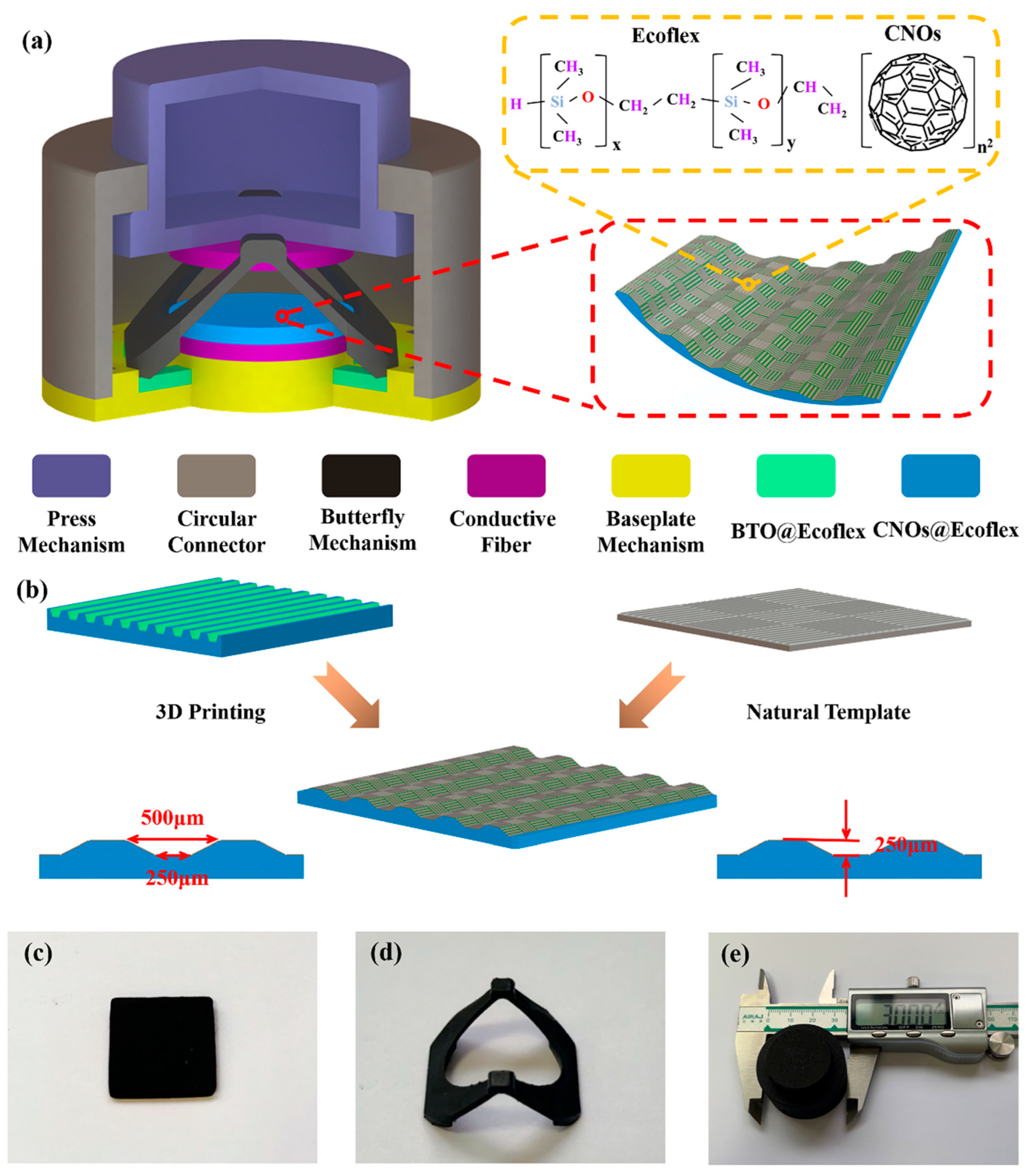

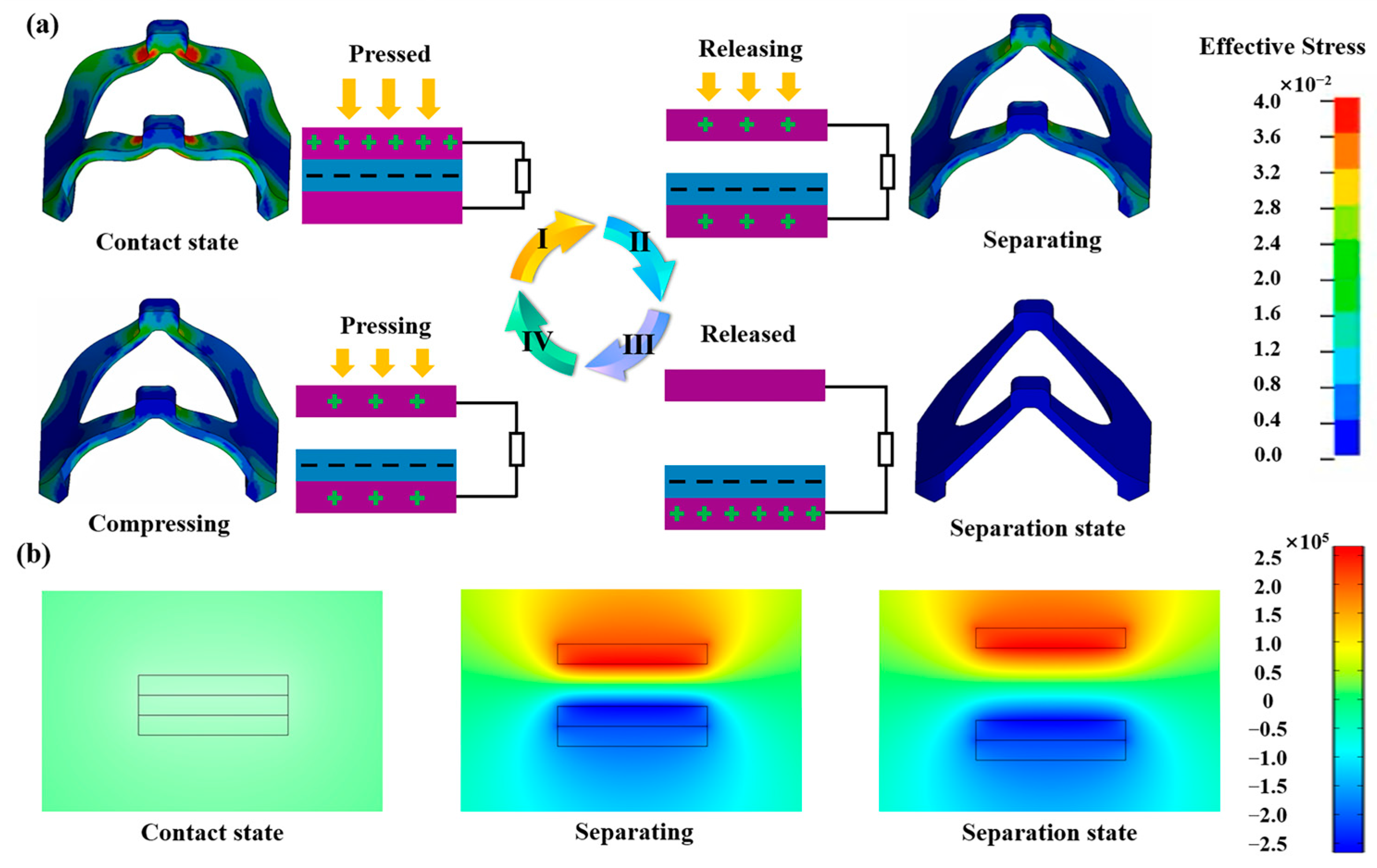
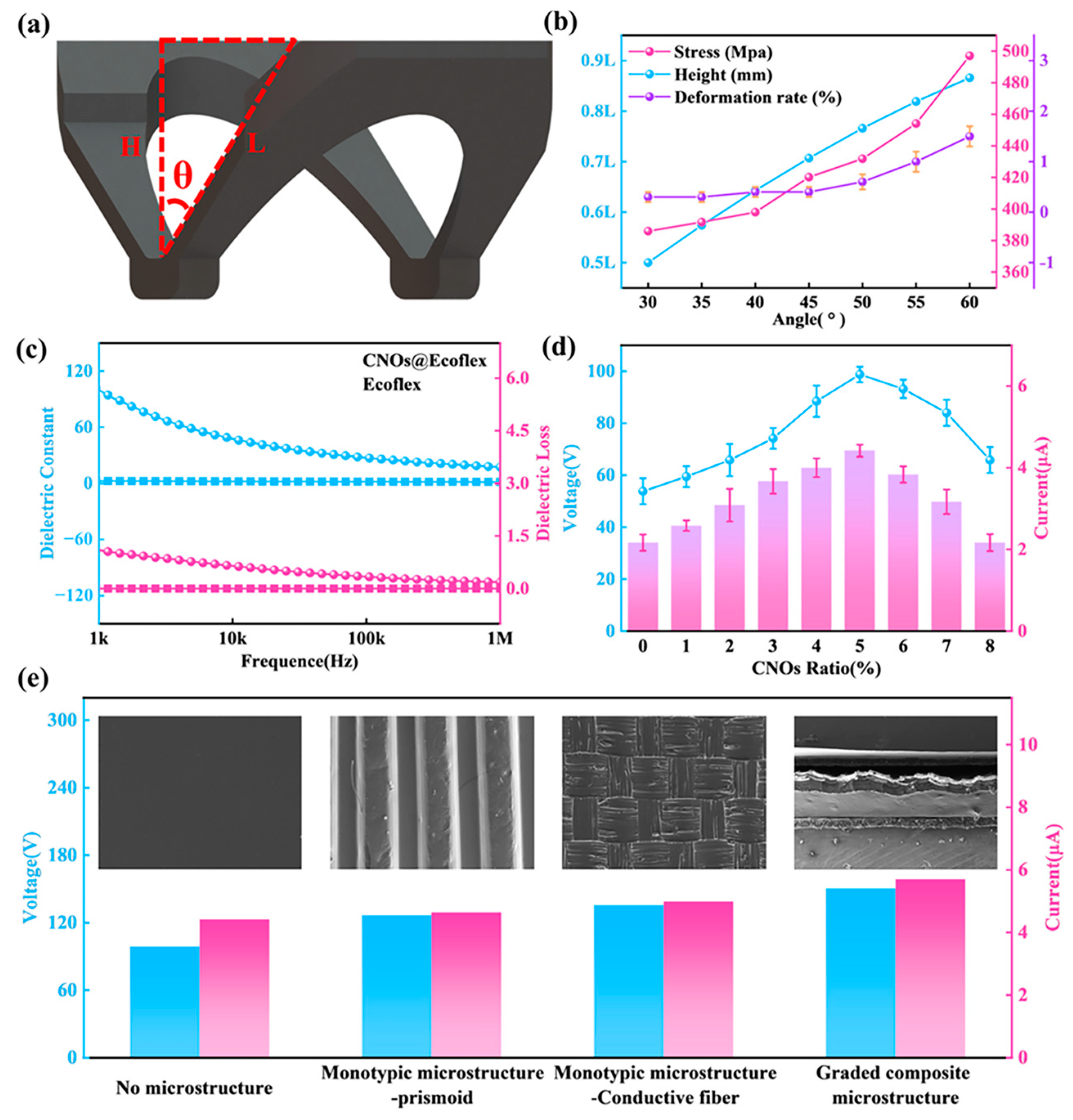

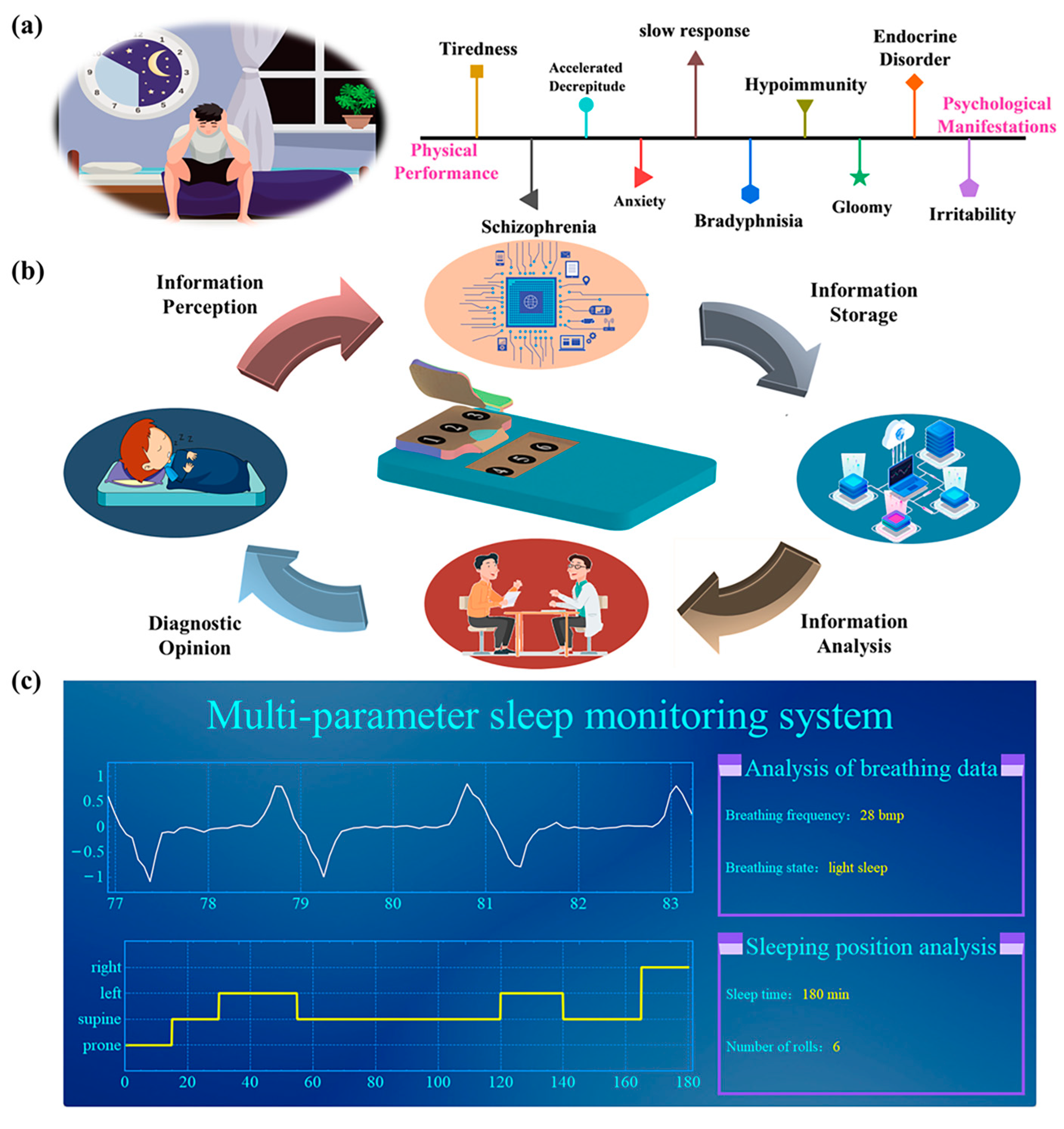
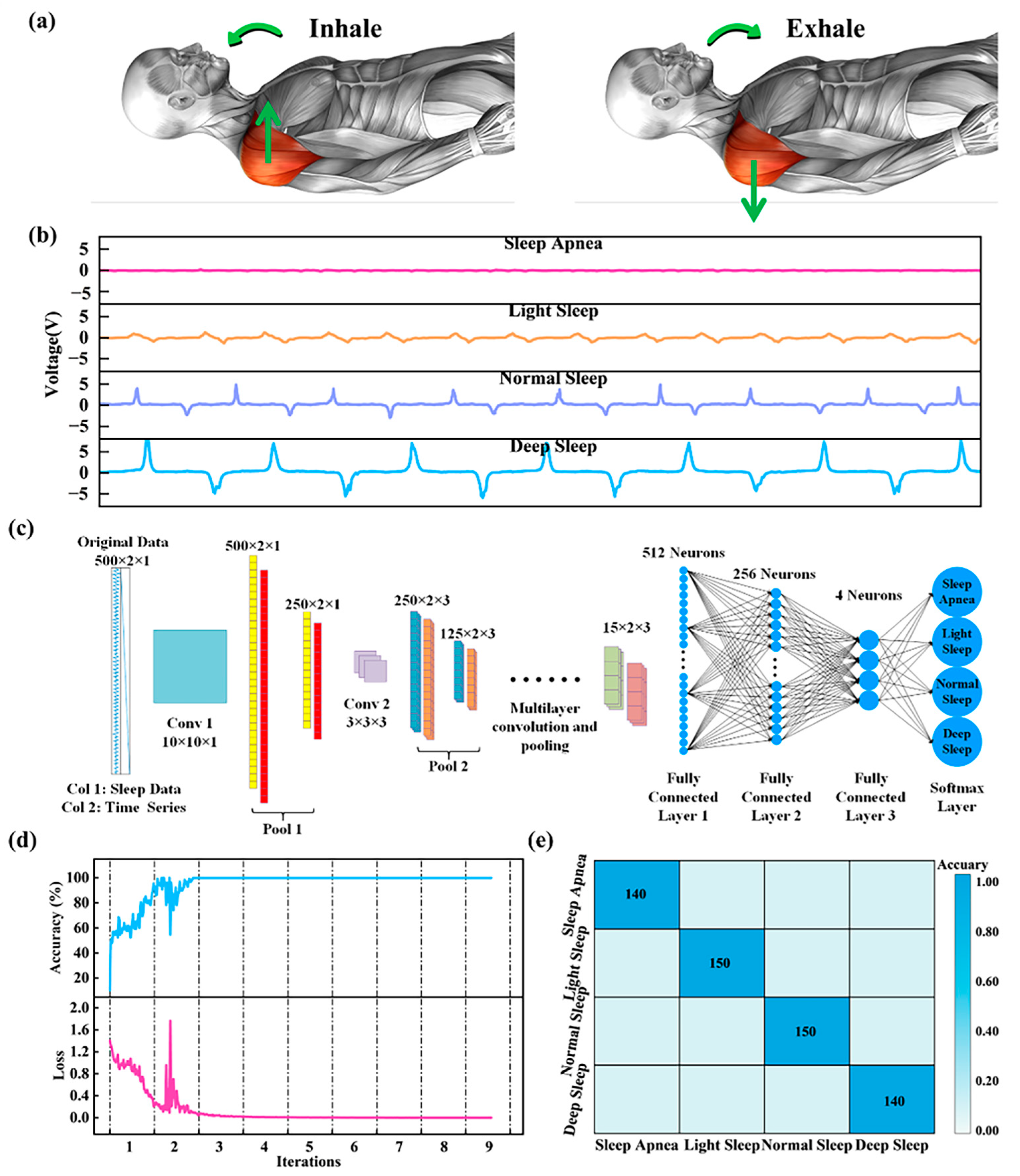

| Sensor Mechanism | Sensitive Material | Pressure Response Range | Limit of Detection | Sensitivity | References |
|---|---|---|---|---|---|
| Triboelectric Sensors | P(VDF-TrFe) and rGO | 1.2 Pa–55 kPa | 1.2 Pa | 15.6 kPa−1 | [24] |
| Triboelectric Sensors | Arbon and polyurethane | Up to 7.27 MPa | - | 0.2 V/N | [25] |
| Triboelectric Sensors | Elastomer and ionic hydrogel | 1.3–101.2 kPa | 1.3 kPa | 0.013 kPa−1 | [47] |
| Piezoelectric Sensor | PVDF and BTO | 12–243 N | 12 N | 0.775 V/N | [48] |
| Piezoelectric Sensor | BTO | 5–50 N | 5 N | 0.05 V/N | [49] |
| Hybrid Sensor | CNOs and Ecoflex | 10–1200 kPa (1–120 N) | 10 kPa (1 N) | 0.246 kPa−1/ 2.46 V/N | This work |
Disclaimer/Publisher’s Note: The statements, opinions and data contained in all publications are solely those of the individual author(s) and contributor(s) and not of MDPI and/or the editor(s). MDPI and/or the editor(s) disclaim responsibility for any injury to people or property resulting from any ideas, methods, instructions or products referred to in the content. |
© 2023 by the authors. Licensee MDPI, Basel, Switzerland. This article is an open access article distributed under the terms and conditions of the Creative Commons Attribution (CC BY) license (https://creativecommons.org/licenses/by/4.0/).
Share and Cite
Zou, J.; Qiao, Y.; Zhao, J.; Duan, Z.; Yu, J.; Jing, Y.; He, J.; Zhang, L.; Chou, X.; Mu, J. Hybrid Pressure Sensor Based on Carbon Nano-Onions and Hierarchical Microstructures with Synergistic Enhancement Mechanism for Multi-Parameter Sleep Monitoring. Nanomaterials 2023, 13, 2692. https://doi.org/10.3390/nano13192692
Zou J, Qiao Y, Zhao J, Duan Z, Yu J, Jing Y, He J, Zhang L, Chou X, Mu J. Hybrid Pressure Sensor Based on Carbon Nano-Onions and Hierarchical Microstructures with Synergistic Enhancement Mechanism for Multi-Parameter Sleep Monitoring. Nanomaterials. 2023; 13(19):2692. https://doi.org/10.3390/nano13192692
Chicago/Turabian StyleZou, Jie, Yina Qiao, Juanhong Zhao, Zhigang Duan, Junbin Yu, Yu Jing, Jian He, Le Zhang, Xiujian Chou, and Jiliang Mu. 2023. "Hybrid Pressure Sensor Based on Carbon Nano-Onions and Hierarchical Microstructures with Synergistic Enhancement Mechanism for Multi-Parameter Sleep Monitoring" Nanomaterials 13, no. 19: 2692. https://doi.org/10.3390/nano13192692
APA StyleZou, J., Qiao, Y., Zhao, J., Duan, Z., Yu, J., Jing, Y., He, J., Zhang, L., Chou, X., & Mu, J. (2023). Hybrid Pressure Sensor Based on Carbon Nano-Onions and Hierarchical Microstructures with Synergistic Enhancement Mechanism for Multi-Parameter Sleep Monitoring. Nanomaterials, 13(19), 2692. https://doi.org/10.3390/nano13192692







